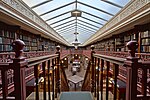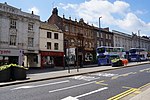Trinity Leeds

Trinity Leeds is a shopping and leisure centre in the city centre of Leeds, England, named after the adjacent 18th-century Holy Trinity Church. Developed by Land Securities and designed by Chapman Taylor, it opened on 21 March 2013, with over 130,000 recorded visitors on opening day.The development is in two parts: Trinity East, a new build development on the site of the former Trinity and Burton Arcades, and Trinity West, the redeveloped Leeds Shopping Plaza. The development has a catchment of 5.5 million people offering a spend of £1.93 billion annually. It has lifted Leeds from seventh to fourth in the CACI UK retail rankings and has created over 3000 jobs. The combined scheme has 93,000 m2 (1,000,000 sq ft) of retail floor space for 120 stores anchored by the flagship Marks & Spencer and Topshop/Topman stores. These units existed as standalone stores and have been expanded and remodelled into Trinity Leeds. The shopping centre has a concept food area in named Trinity Kitchen, hosting both permanent tenants and rotating "pop-up" vendors. Everyman Cinemas opened a 3,700 m2 (40,000 sq ft) four screen art-house cinema in the centre, its first premises in the north of England.
Excerpt from the Wikipedia article Trinity Leeds (License: CC BY-SA 3.0, Authors, Images).Trinity Leeds
Albion Street, Leeds Holbeck Urban Village
Geographical coordinates (GPS) Address Phone number Website External links Nearby Places Show on map
Geographical coordinates (GPS)
| Latitude | Longitude |
|---|---|
| N 53.797 ° | E -1.545 ° |
Address
Trinity Leeds
Albion Street
LS1 5AT Leeds, Holbeck Urban Village
England, United Kingdom
Open on Google Maps











